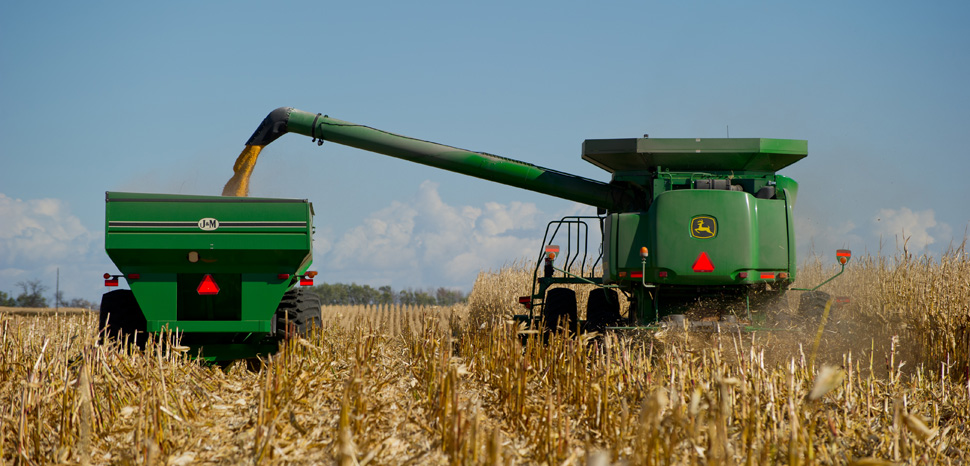Sparse hints of spring are just beginning to tease the eastern seaboard as the slow recession of winter finally begins. Still, going west of the Mississippi River will bring you perilously close to where Jack Frost’s reign of terror isn’t over yet. Record setting temperatures continue to slow life’s pace not just for the people, but for the local economies; which means farmers.
Harsh conditions are an occupational hazard in this industry, yet that doesn’t make them any less of a threat. But the chilly weather isn’t the only thing nipping at their patience these days.
Being an American farmer isn’t what it used to be. An honest day’s work doesn’t only include an alarm set for 6:00 a.m. and a healthy appreciation for a combine anymore. Even for the small farm, it requires an understanding of technology, international markets, and a firm grip on a future that has never been so severely in question.
Farming was never easy, but the economic realities of the 21st century have erased the picture-perfect image of American agricultural supremacy. In 2012-2013, Brazil surpassed the United States to become the world’s chief exporter of soybeans, and is poised to beat American farms in the beef industry. The United States is now 4th in wheat production, 4th in potatoes, and is fast losing its 1st position in maize. China is now the world’s main exporter of wheat, utilizing the fertile Yellow River and Huai River Valleys in ways the U.S. can’t match. The depressing truth is that the United States is no longer the world’s breadbasket.
The slow demise of the American farmer has been at the center of US domestic politics for decades, and it seems every politician within 100 miles of a silo has an answer that will somehow help them with rural constituents.
The array of symptoms that afflict this dying symbol of American cultural and economic preeminence is mostly modern, but it is not necessarily new. Agricultural studies from the US government have shown that US farms have been on the decline since the 1970s, with the peak number being 6.8 million in 1935. By 2002, it was only 2.1 million.
The slow demise of the American farmer has been at the center of US domestic politics for decades, and it seems every politician within 100 miles of a silo has an answer that will somehow help them with rural constituents. Putting aside any instinctive need to pander, the sad reality few consider is that maybe this was inevitable.
Historically, America’s agricultural power partially stemmed from an unchallengeable reserve of resources and land, not to mention unprecedented technological progress through innovation. Eventually, America’s self-sustainability became one of her greatest strengths in international diplomacy. Her sources of food were usually secure out west, which in turn prolonged a foreign policy of isolationism. Unlike the rest of the Western world, America didn’t have a vested interest on the world stage in terms of survival. In notable contrast, Europe – particularly Britain – was highly dependent on her colonies for much of the 20th century for maintaining its place near the top in terms of agriculture. Even today, more than half of the United Kingdom’s food comes from overseas. The continent as a whole in 2007 imported an amount equal to the production of 86.5 million acres of farmland.
As early as the 1830s, American cash crops had arrived as a powerful force in international markets. By the time the Civil War began, US imports were so pivotal to European economic stability that Britain and France considered the possibility of sacrificing decades of moralistic opposition to slavery and openly intervening on behalf of the slaveholding confederacy. King Cotton was responsible for the existence of millions of European jobs at the time, especially in the industrial sector.
The international landscape at the end of both World Wars was immensely favorable to the United States, especially economically. As the only major power that did not face extensive fighting on home territory, the giant protected by two oceans was left unscathed by the devastation that had ravaged much of the world. Europe was crippled, Africa colonized, Asia war-torn, and South America impoverished. The lack of rivals throughout the industrialized world against U.S. economic power was a temporary state that should’ve been expected to end, and it did.
The world recovered and as more nations joined the global community as serious powerbrokers, US power diminished. China emerged from Deng Xiaoping’s capitalist reforms eager to challenge the U.S. economically, India began reaping the benefits of Norman Borlaug’s dwarf wheat, and South America slowly began to harness the power of her fertile soil. As this shift became evident domestically, the blame game began. But the most common misconception that arose was that this recession of American economic might was the byproduct of lackluster efforts to preserve it. On the contrary, these developments have been in spite of those efforts.
In 1961, the U.S. was the undisputed king of maize at 91,388,000 tons produced in a single year. In 2016, production soared to 384,777,890 tons. Yet it’s place at the top is in question as in the same year China leaped to second with 231,673,946 tons.
Here we see the inevitable result of globalization and free trade: fierce competition. That doesn’t always benefit everyone. However, not every threat to this all-American way of life is foreign.
As a result of growing pressure across the globe, domestic consolidation of farmland has been increasing. In the early 1950s, U.S. farms began decreasing in numbers while drastically expanding in scale. Today, the top 10% of farms in size account for 70% of total cropland nationally. As a result, a select few US Agricultural giants own the majority of the crop market share, which greatly contributes to the pressures of smaller farms. In 2013, Nestle had over 100 billion in sales worldwide. The sheer power of these large companies is staggering and the control they are consolidating is part of the problem. And that dilemma, only a little a while ago, got a whole lot worse.
Back in October of 2017, USDA Secretary Sonny Perdue announced he would be ending the GIPSA rule, which gave small farms the legal arms to fight back against monopoly practices from bigger companies. It’s not entirely uncommon for large companies like agriculture giant Monsanto to take measures aimed at keeping smaller competitors in check, but in more ways than just cruel economic tactics.
GMOs are a hot topic in the United States, but for countless farmers, using genetically modified seeds has become a necessity. Monsanto has sued hundreds of smaller farms for replanting crops that originated from Monsanto’s modified seeds. They view it as a patent violation, while the small farmer views it as imperative to keep up with the competition. Unfortunately, the law doesn’t share the latter opinion. In 2013, Indiana farmer Vernon Hugh Bowman took on Monsanto at the United States Supreme Court and lost. America’s highest court unanimously ruled that Bowman had to pay Monsanto a fee for continued usage of the seeds.
The intrinsically complicated laws of free market capitalism seep in here to make an already tough debate even harder, but the basic fact remains that the monopoly established by Monsanto and others in the seed industry has left thousands of small farms with little to no options if they want to remain relevant. Bowman v. Monsanto Co. established a precedent where farms will now be continually trapped into paying high fees for the advanced seeds they need. Even in Justice Elena Kagan’s opinion for the court there was a clear acknowledgement of the impact these modifications had, writing “we recognize that such inventions are becoming ever more prevalent, complex, and diverse.”
Studies from the Center for Food Safety and the Save Our Seeds campaigning groups have come to the conclusion that Monsanto’s aggressive campaigns against smaller companies go hand-in-hand with other multinational conglomerate legal actions to paint a clear picture: they have sown the seeds for cornering the market. Quite literally.
Washington has usually blazed its own regulatory path regardless of international standards or advice.
The research found legal prosecution had affected 410 farmers, 56 small businesses in almost 30 states, and won nearly 23 million dollars as a result. The worst part? 53% of the seed industry was controlled by three companies worldwide: Monsanto, DuPont, and Syngenta. GMOs remain banned in 26 countries, which leaves the United States as one of the few industrialized nations that faces this problem. And even as the United Nations continues to recommend other forms of agricultural expansion, the U.S. continues to flatline on one of the biggest reasons small farms are struggling.
Washington has usually blazed its own regulatory path regardless of international standards or advice. That’s always had arduous effects on the agricultural sector, and the new administration is adding significant changes in the recently passed GOP tax bill that will further complicate the matter.
Under the bill, farms structured as corporations or partnerships could see a tax cut as drastic as 10% – a grandiose reduction and a net positive on the surface. Yet senior advisor for the National Sustainable Agriculture Coalition, Ferd Hoefner, estimates that farms amassing over $1 million in annual sales will see the most relief, meaning a lot of smaller farms won’t be helped. In fact, it could be quite the opposite.
Farms operating as co-ops will lose big, as the elimination of the Section 199 deduction could take away almost 2 billion in revenue based on expense deductions. The National Council of Farmer Cooperatives strenuously opposed the rollback, and even united over 150 farm advocacy groups against the move. Around 80% of the US milk industry is represented by co-op businesses, meaning it’s not just Kansas that will hurt from the move. Besides a few Senators out west like Montana Democrat John Tester and Iowa Republican Chuck Grassley, very few brought up the issue. One thing’s for sure: if the tax bill doesn’t kill the small farmer, it certainly won’t save him.
For the heartland, the effects are real and being felt in everyday lives. The gradual decline in prices, especially for wheat and corn, is pushing farmers in Kansas further into debt. “Whenever you have low prices like this, everyone goes hungry,” local farmer Tom Giessel was quoted as saying in the Topeka Capital-journal. “County governments, state governments, and rural economies suffer along with the farmer.”
For the small farmer, maximizing yield and significantly reducing input costs is the only way to stay in business. The recent MATE Show in Billings, Montana, is only one of a few exposes across the country promoting new tech to a farm community in desperate need for cost reductions. “Compared to the eastern markets, adoption is a little slower out here but as far as the nuts and bolts, the autosteer and stuff like that, adoption has been pretty universal,” Montana Ag consultant Travis Anderson said in an interview with local newscaster KRTV. “The display that comes with this tractor, whatever you punch into it, whether you’re putting down map, seed variety or anything like that, can track inputs back to our website,” Anderson said. “And that allows you to kind of do your own little agronomy trials on your farm. Try something different in this field versus this one and track it to see which one made you more money.”
These so-called production costs that are driving many out of business aren’t just relegated to equipment. It is estimated that almost 39% of U.S. farmland is actually leased to farmers, meaning a large portion of where you get your food probably wasn’t grown on land that the farmer legally controls. The amount of money needed to access the real estate needed for planting is, once again, sometimes too costly for smaller farms to have access to. Iowa State University found in a recent study that in 1970, you could buy land in the state for $419 an acre. In 2016, the price was roughly $7,183, which is an increase of 1,600%.
For all the industries millennials are supposedly killing, local agriculture is definitely not one of them.
Still, there is some hope for local farming. In Colorado, initiatives like the Colorado Proud program provide consumers with the knowledge that their food was locally grown, and it’s been wildly successful since its implementation in 1999. It represents a growing social trend, principally with younger generations, that’s putting emphasis on organic and home-grown foodstuffs. “Buying locally has become more of a focus from younger generations,” said Chris Wiseman, deputy commissioner of the Colorado Department of Agriculture. “I know people who look for these labels in grocery stores because they feel like they’re helping a neighbor.”
For all the industries millennials are supposedly killing, local agriculture is definitely not one of them. The upcoming generation makes up 52% of those who consume organic foods, eats 52% more vegetables than older age groups, and roughly 40% are reportedly exercising a plant-centered diet with their eating habits. While healthy cultural patterns alone can’t save American farming, it’s certainly stopping some of the bleeding.
But despite state government programs and differing generational appreciation for small-time farming, the USDA has already predicted that profits for the industry in 2018 will be the lowest since 2006, and studies have shown overall revenue has dropped by almost 50% in the last four years. In addition, there are genuine worries that the attraction of farming is too low for sustainability generationally. For the first time in history, there are more farmers who are older than 65 rather than below 45. Even the suicide rate for those in farming is up, almost double that of veterans.
Sadly, it seems the overly romanticized paintings of Grant Wood and the classic landscapes gorgeously depicted by Currier & Ives might be all that’s left of agricultural Americana these days. Perhaps this was always meant to happen; maybe the natural course of free market capitalism dictates the eventual collapse of every economic powerbroker. We can only hope that the rise and fall of the American farmer is not, in its own sadistic way, an inner representation of the general deterioration of American power.
The opinions, beliefs, and viewpoints expressed by the authors are theirs alone and don’t reflect any official position of Geopoliticalmonitor.com.




